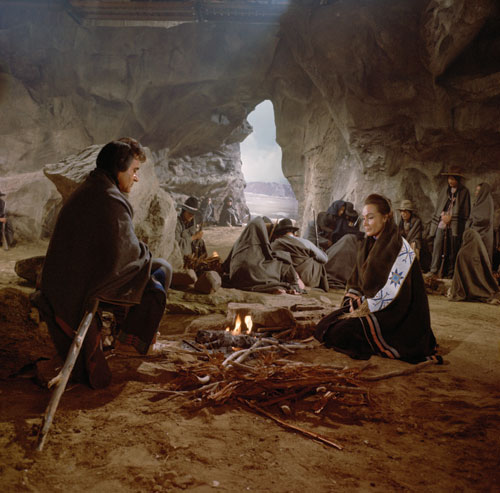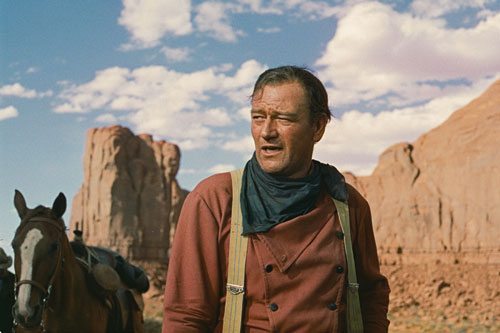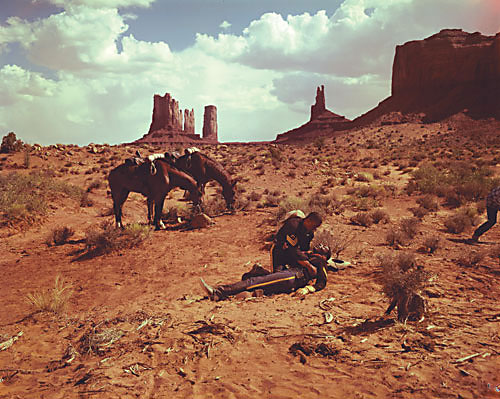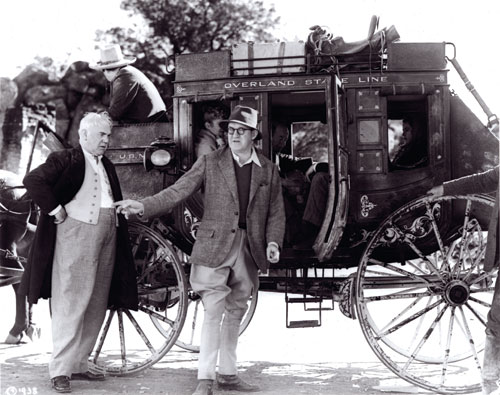BY JOSEPH MCBRIDE
 John Ford's Cheyenne Autumn (1964) (Credit: Warner Bros.)
John Ford's Cheyenne Autumn (1964) (Credit: Warner Bros.)
As John Ford's career was ending in the late 1960s amid general indifference and even derision from many American reviewers, critic Andrew Sarris wrote eloquently of the director's final feature, "The last champions of John Ford have now gathered around 7 Women as a beacon of personal cinema." Today, Ford's stature as the greatest American filmmaker is widely acknowledged, yet he tends to be honored more in pro forma ways than with the basic tribute of watching his films. His work has a devoted following among Ford aficionados, and movie fans of a certain age keep him in some demand on cable TV networks. But it is a disheartening fact that younger audiences seem to have little interest in Ford, his historical themes, or his classical style—a reflection of how far our country has strayed from its pioneer roots and from the foundations of American moviemaking.
 John Ford's The Searchers (1956) (Credit: Warner Bros.)
John Ford's The Searchers (1956) (Credit: Warner Bros.)
With the virtual extinction of repertory cinemas in this country since the advent of home video, Ford's work is seldom seen where it truly belongs, on the big screen. A painterly filmmaker whose work resembles a Frederic Remington or Charles Russell canvas come alive in flowing, lyrical movement, Ford had, I think, the best eye for composition of any filmmaker who ever lived (literally one eye in his piratically eye-patched last two decades). Toward the end of his life, dropping his usual pose as simply a "hardnosed" journeyman, he described himself as the best cameraman in the business. But when his work is shrunk to the dimensions of the TV screen, it loses dramatic nuances as well as sheer visual luster and depth.
I never fully appreciated Ford's 1964 Technicolor and widescreen epic Cheyenne Autumn until I saw it in 35 mm at the Los Angeles County Museum of Art in 1994, which made me understand that the story is told more through visual poetry than through conventional narrative. Since the film suffers from obvious casting flaws and other narrative compromises, it has been seriously underrated over the years by critics and viewers who have never seen it the way Ford and cinematographer William H. Clothier meant it to look (it's not possible at present to see the film in its original Super Panavision 70, which must be even more three-dimensionally spectacular). Nor could I appreciate Ford's black-and-white Western classic Stagecoach in the miserably washed-out and scratchy prints that were the only ones available for many years. Since the original negative has been destroyed, the film's rich visual texture, its almost film-noirish depth and complexity of light and shadow, was not apparent. It was only when I saw a 35 mm copy at the Library of Congress, made from an original nitrate release print donated by John Wayne, that I finally came to understand Ford's visual and emotional intentions.
 John Ford's Sargeant Rutledge (1960) (Credit: Warner Bros.)
John Ford's Sargeant Rutledge (1960) (Credit: Warner Bros.)With TV screens getting bigger and wider as theater screens keep getting smaller, and with the DVD market demanding ever higher standards of preservation and presentation, it is becoming possible to once again savor the range and artistry of Ford's pictorial style. Warner Home Video has released thirteen Ford features in two new and indispensable DVD sets, The John Ford Film Collection and The John Wayne-John Ford Film Collection. (Included in both these DVD sets are several documentaries which I'll refrain from evaluating since I was interviewed for some; I also did the audio commentary for Cheyenne Autumn.)
This ambitious though imperfect enterprise enables us to see some of Ford's masterpieces along with some of his lesser works, offering a representative panorama of his sound film career from the 1930s through the 1960s. It also shows how he was able to sustain his artistic viability with a canny mixture of films made as a studio craftsman and riskier films made out of personal obsessions.
Some of the best films in the set are, ironically, the ones he directed at the behest of studios (such as his magnificent 1945 elegy for the men who sacrificed themselves in the early days of World War II, They Were Expendable), or to keep his independent production company solvent (such as his cavalry films Fort Apache and She Wore a Yellow Ribbon). Those that stemmed from more personal imperatives include some of his weakest (such as the stilted and overwrought Mary of Scotland, made because he was in love with Katharine Hepburn) as well as some of his finest (among them The Searchers, his 1956 epic Western about the racism at the core of the American psyche).
Warner Home Video has gone to some lengths to restore or at least clean up some of the prints to bring out their original quality. But this collection is less than the ultimate restoration enterprise that one might have hoped. Cheyenne Autumn is perhaps the one real treasure of the collection, for not only does the print look lustrous, but this is the first time this film maudit has been released to home video in its uncut, widescreen roadshow version.
 Ford directing a scene from Stagecoach (1939) (Credit: AMPAS)
Ford directing a scene from Stagecoach (1939) (Credit: AMPAS)
Warners is especially touting its newly "restored" print of The Searchers and "remastered" Stagecoach, but despite these efforts, both are diminished versions of the originals. The negative of The Searchers has deteriorated over the years, and Winton C. Hoch's cinematography of Monument Valley is conveyed here in a somewhat fuzzy and pallid copy, with day-for-night scenes printed too darkly. It's a distant echo of the stunning 35 mm Technicolor print I first saw at Chicago's Clark Theater in the 1960s, not to mention the original VistaVision print Martin Scorsese watched in New York in 1956. In a documentary accompanying this new DVD of The Searchers, Scorsese says, "I cannot tell you what that VistaVision looked like projected—there's nothing today that can equal that... I've never seen figures in a landscape that wide to have such an emotional resonance, and the poetry in his language, the visual language." The new print of Stagecoach clearly conveys the visual design of Ford and cinematographer Bert Glennon, but some of the shadows still appear a bit muddy.
Better-preserved films in these collections include 3 Godfathers, perhaps Ford and Hoch's most beautiful color film, and The Informer, a tour de force of no-budget expressionism by Ford and his ace black-and-white cinematographer Joseph H. August, crisply reproduced from the original negative. The Ford-Hoch Technicolor spectacular She Wore a Yellow Ribbon looks wonderful, but August's crowning achievement for Ford, They Were Expendable, suffers intermittently here from image instability. The color of the Ford-Glennon 1960 Western Sergeant Rutledge is disappointingly soft, and when title character Woody Strode is serenaded by his fellow "Buffalo Soldiers" in a night scene shot on a soundstage, Warners has printed the scene so brightly that in Strode's closeups you can see the overhead lighting catwalk!
Some of Ford's quirkier masterpieces unfortunately remain AWOL on DVD in this country and would form the nucleus for a splendid John Ford Film Collection II. I especially miss three of his finest works, The Sun Shines Bright, Wagon Master and 7 Women. The unjustly maligned 7 Women needs to be reunited with the six minutes MGM cut before the film's release in 1966 (the footage still exists and surfaced on TV syndication in the 1970s). Ford's offbeat three-part Irish film The Rising of the Moon, made for Warner Bros. in 1957, has never been released on home video. And not one of Ford's relatively few extant silent films is available on DVD in the U.S., not even his 1924 epic The Iron Horse. Let's hope a fuller library of Ford's vast body of work will eventually emerge for home viewing so that new generations of movie lovers will be able to rediscover this giant of American filmmaking.
Joseph McBride is the author of the 2001 biography Searching for John Ford and co-author (with Michael Wilmington) of the 1974 critical study John Ford. McBride's next book, What Ever Happened to Orson Welles?: A Portrait of an Independent Career, will be published in October by the University Press of Kentucky.